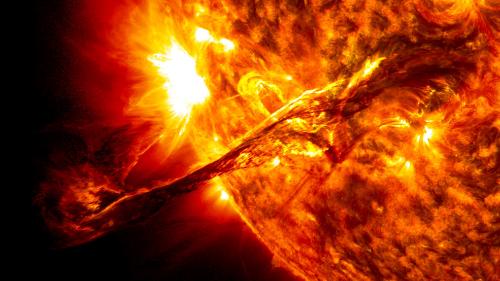Powers of Nature - Solar Energy
Read about how writers and inventors have responded to the Sun's power and then try and do one of the writing exercises at the bottom of the page.
The amount of energy coming from the Sun to the Earth is immense, as this video shows us. In fact, the Sun radiates more energy in one second than the world has used since time began!
 Photo Credit: NASA
Photo Credit: NASA
Ultimately, all of the Earth’s energy come from the heat and light produced by the Sun, as it drives all of the physical and biological processes around us. For instance, even fossil fuels are the result of plant-life grown via photosynthesis millions of years ago. The Sun warms the atmosphere, creating the world’s weather, and so even wind turbines are in a sense solar-powered. But there are more direct forms of solar power technology now in use, including photovoltaic solar cells (which convert the Sun’s light into electricity) and concentrated solar power (which uses mirrors and/or lenses to focus the Sun’s light onto a small area, often to generate heat which turns an engine).
Harnessing solar power directly is often assumed to be a new thing, but actually humans have for centuries been making solar technologies, such as ‘burning glasses’ (convex lenses or concave mirrors) which focus the Sun’s rays to heat things and start fires. At the same time, writers and artists have been fascinated by the possibility of using solar energy, and stories about solar power have themselves had a role to play in the development of science and technology.
In the below video Dr Greg Lynall from the University of Liverpool talks about the history of Solar Technologies:
For over a hundred years, science fiction stories have imagined how solar power could be used, for good or ill: as both a creator or a destroyer. In these stories, solar power is often associated with sublime (awe-inspiring, boundless and potentially frightening) technologies through which people try to assert their dominion over the natural world. This pursuit is normally never without consequence. One very recent example you might know is Star Wars: The Force Awakens, in which the First Order’s ‘Starkiller Base’ drains energy from the nearest star and converts it into a beam of radiation that destroys five planets! But in a film also from 2015, The Martian, based on Andy Weir’s 2011 novel, solar cells are the astronaut Mark Watney’s only source of power when stranded on the red planet. The Martian reminds us how important solar power is to space exploration, because transporting heavy fuel from Earth is very difficult, so this is where photovoltaic cells really come into their own. For instance, the International Space Station, recently visited by British astronaut Tim Peake, is powered by 4 huge arrays of solar panels. But relying on solar power in space isn’t always easy. When the European Space Agency sent the Rosetta Probe to investigate Comet 67P/Churyumov-Gerasimenko, its Philae lander unfortunately ended up on the comet’s surface with its solar panels in shadow, and barely managed to generate the power needed to send back data. (It was, nevertheless, a brilliant scientific feat to land a probe on a comet travelling at up to 84,000 miles per hour and 300 million miles away from Earth!). The poet Mario Petrucci has written a poem about the Philae lander which you can read here along with his story about the poem.
Solar power is useful not only up in space, but also here on Earth, where it is now recognized as a way of providing sustainable and non-polluting energy at a time of climate change as well as jobs in a new industry.
Some Questions:
1. After watching Dr Lynall's video imagine you are one of the historical figures who is exploring how to harness the power of the Sun via magnification or reflection. What have you discovered? What do you want to do with this power? Now write a story about it.
2. You are on a Space Agency probe that has gone off-course and is heading toward the sun. Describe what you see and what you feel.
3. Try and write a poem where the lines (or stanzas) alternate between the dangers and the benefits of the Sun.